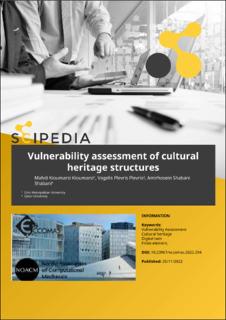| dc.contributor.author | Kioumarsi, Mahdi | |
| dc.contributor.author | Plevris, Vagelis | |
| dc.contributor.author | Shabani, Amirhosein | |
| dc.date.accessioned | 2023-02-20T09:40:10Z | |
| dc.date.available | 2023-02-20T09:40:10Z | |
| dc.date.created | 2023-02-09T12:07:13Z | |
| dc.date.issued | 2022 | |
| dc.identifier.isbn | 9788412322286 | |
| dc.identifier.uri | https://hdl.handle.net/11250/3052232 | |
| dc.description.abstract | Cultural heritage (CH) assets are the legacy of a society that are inherited from the past generations and can give us lessons for contemporary construction. Not only the formally recognized CH assets but also the non-CH structures and infrastructure, and the interconnection between them are crucial to be considered in a vulnerability assessment tool for the sustainable reconstruction of historic areas. Since most CH assets were not designed based on robust design codes to resist natural hazards such as earthquakes, vulnerability assessment and preservation are pivotal tasks for the authorities. For this aim, Hyperion, an H2020 project (Grant agreement No 821054), was formed in order to take advantage of existing tools and services together with novel technologies to deliver an integrated vulnerability assessment platform for improving the resiliency of historic areas. Geometric documentation is the first and most important step toward the generation of digital twins of CH assets that can be facilitated using 3D laser scanners or drone imaging. Afterward, the finite element method is an accurate approach for developing the simulation-based digital twins of cultural heritage assets. For calibration of the models, the result of the operational modal analysis from the ambient vibration testing using accelerometers can be utilized. Structural analysis for the prediction of the structural behavior or near real-time analysis can be carried out on the calibrated models. However, the full finite element analysis needs a lot of computational effort, and to tackle this limitation, equivalent frame methods can be utilized. | en_US |
| dc.language.iso | eng | en_US |
| dc.publisher | ECCOMAS | en_US |
| dc.relation.ispartof | 8th European Congress on Computational Methods in Applied Sciences and Engineering (ECCOMAS Congress 2022) | |
| dc.relation.ispartofseries | ECCOMAS Congress;8th European Congress on Computational Methods in Applied Sciences and Engineering | |
| dc.relation.uri | https://www.scipedia.com/public/Kioumarsi_et_al_2022a | |
| dc.rights | Navngivelse-Ikkekommersiell-DelPåSammeVilkår 4.0 Internasjonal | * |
| dc.rights.uri | http://creativecommons.org/licenses/by-nc-sa/4.0/deed.no | * |
| dc.title | Vulnerability assessment of cultural heritage structures | en_US |
| dc.type | Conference object | en_US |
| dc.description.version | publishedVersion | en_US |
| cristin.ispublished | true | |
| cristin.fulltext | original | |
| cristin.qualitycode | 1 | |
| dc.identifier.doi | https://doi.org/10.23967/eccomas.2022.294 | |
| dc.identifier.cristin | 2124483 | |
| dc.source.pagenumber | 1-16 | en_US |
| dc.relation.project | EU/HYPERION_No 821054 | en_US |

